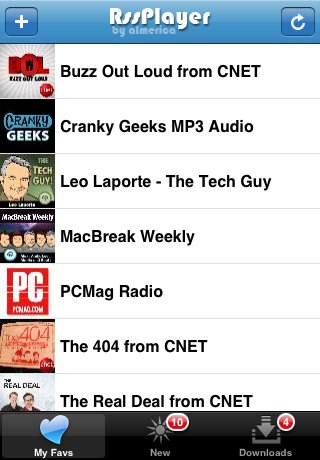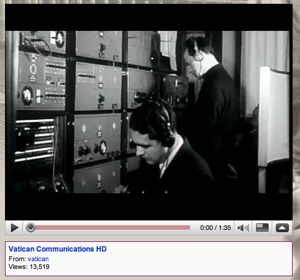Latest News
Podcaster iPhone App Reborn As RSS Player, But Still Handicapped By Apple
Jan 27th, 2009 | By James Lewin | Category: Audio Podcasting, iPods & Portable Media Players, Podcast Distribution, Podcasting, Podcasting Software  Earlier in the year, we reported on Apple’s banning of the Podcaster iPhone app from the App Store.
Earlier in the year, we reported on Apple’s banning of the Podcaster iPhone app from the App Store.
At the time, Apple explained its decision like this:
Since Podcaster assists in the distribution of podcasts, it duplicates the functionality of the Podcast section of iTunes.
We called this a bad decision on Apple’s part, because it “sends the signal that people shouldn’t develop podcast-related applications for the iPhone.”
Now a stripped-down version of Podcaster, RSS Player (App Store link), has been approved and is available in the App Store. It’s basically Podcaster, without a built-in podcast directory.
Here’s the description:
Specifically designed to play audio files attached to rss feeds.
Start by entering an rss feed url or opml url into the import screen, then the program crawls the feed and displays the items it finds in an easy to read table. If the program finds an audio file attached to the feed, it will automatically download the most current one. This makes it easy for iPod Touch owners to listen when they are offline.
This is a really great app with high standard. We will keep improving it and adding features in future releases. If you purchase this app, we are sure you will love it.
While we’re glad to see Apple loosening up its restrictions on iPhone apps, RSS Player is still significantly handicapped by Apple’s application rules:
- Podcasts are downloaded into a “sandboxed environment”, so they can’t be used with other applications.
- RSS Player has to be open to listen to downloads, so you can’t listen to podcasts and use your phone for other purposes.
- RSS Player has no discover tools, so you have to write down feed URLs, open RSS Player and then type in the URLs.
What do you think of RSS Player? Is it a big deal, because Apple’s opening up to other podcast clients, or is it dead on arrival because of the limitations that Apple places on third party apps?
YouTube Now Lets You Delete Your Video Comments
Jan 26th, 2009 | By James Lewin | Category: Video  YouTube announced today that it had updated the site to allow you to edit your own video comments:
YouTube announced today that it had updated the site to allow you to edit your own video comments:
We’re happy to announce the launch of a feature many of you have been asking for. Now you have the ability to delete comments you’ve made on videos. We’ve all been there. Whether you misspelled “pwned”, back in the day when you were just a n00b to the internets, or you simply said something you wish you could take back – now you can remove your commentary at any time.
The Abuse & Safety tool is here for you to resolve issues like harassment and bullying. This new feature will empower you to more easily and effectively handle these types of situations, without needing help from staff. Of course, we always encourage everyone to think things through before posting comments anywhere on the site. But if you don’t get it right the first time, now you can simply delete your comment. To remove a comment that you’ve made, go to the “Text Comments” section below the video and click the “Remove” button next to your comment.
This is a needed update – but it would have been nice if they limited changes to your current visit. Otherwise, people can delete ancient comments and mess up the flow of older comment discussions.
The Next Right Looks For ‘Battleground’ Bloggers
Jan 26th, 2009 | By Elisabeth Lewin | Category: Citizen Media, New Media Organizations  Republican blogger and strategist Patrick Ruffini is looking for “a few good bloggers” to help cover local political races and grassroots initiatives from a conservative perspective.
Republican blogger and strategist Patrick Ruffini is looking for “a few good bloggers” to help cover local political races and grassroots initiatives from a conservative perspective.
“Project Battleground” is Ruffini’s initiative to gather activist bloggers and conservative websites at the state and local level in “every battleground state and every competitive Congressional district” throughout the United States.
Following the GOP’s big losses in the 2008 general elections, Ruffini sees the political cup as half-full, and the time just right — for the party, and for displaced Republican operatives — for launching a bevy of local political blogs.
His reasoning (greatly simplified by me):
“The states are where the mainstream media is breaking down big time…. Media coverage in these areas won’t just go away; it will move to the Web and the blogosphere. Many of the reporters and journalistic resources at cash-strapped newspapers will likely land at left-wing ‘alternative’ news websites.”
So–
“We need conservative websites and blogs in every state that are dedicated to winning those states. They should be run by sophisticated activists or consultants who know how politics works…, or young up-and-comers who are interested in … prov[ing] themselves.”
And–
“Republican operatives now find themselves with decidedly fewer opportunities for career advancement as a result of the last election…. There is no better way to get your name out there than to become a public voice in the political debate in your state, and to do it using new media.”
The Next Right, the blog Ruffini co-founded, is a “place for wired activists to build a new Republican Party and conservative movement.” The site calls itself a grassroots action website for the right with political analysis, local news coverage, and strategic discussion and debate.
From our point of view, this Project Battleground is a welcome development in the world of politics and new media (even if – perhaps especially if – it doesn’t align with our personal political ideology). In a democracy, the party in power needs a strong opposition party in order to keep them (us) “on their toes.”
The Next Right, and the local blogs they hope to spur to action, have a long, hard way to go, though, to catch up with more liberal political blogs and blog networks. The liberal and progressive blogs and blog networks Huffington Post, Daily Kos, and Center For Independent Media all have several years’ head start on this new conservative blogging initiative. Ruffini has an impressive new media resume, though, and may just be the guy to coordinate the efforts of local GOP bloggers.
We’ll keep an eye on this project and let you know.
And Now For Something Completely Different: Monty Python And Making New Money With Old Stuff
Jan 24th, 2009 | By Elisabeth Lewin | Category: Commentary, Digital Music, VideoYesterday’s article, about the newly-launched Vatican channel on YouTube, reminded us of a favorite Monty Python sketch, “The Pope and Michaelangelo,” which we embed here for your amusement.
“Look – I’m the bloody Pope, I am! I may not know much about art, but I know what I like!” Priceless.
It got me off on a tangent, thinking about the different ways in which people and organizations are using YouTube and other new media to expand the reach of their “brand.”
This “Pope” video is on the “From the Vatican” playlist on the Monty Python Channel on YouTube. While their content is something completely different from what you’ll find on the Vatican’s YouTube channel, Python is an excellent example of someone turning a vast storehouse of old content into a new revenue source.
Monty Python took classic old skits from their “Flying Circus” television show, scenes from the “Holy Grail” and “Life of Brian” movies, and bits of their Amnesty International “Secret Policeman’s Ball” performances. They added recent video commentary from troupe members, and offered the entire caboodle for free.
Their reasoning?
“For 3 years you YouTubers have been ripping us off, taking tens of thousands of our videos and putting them on YouTube. Now the tables are turned. It’s time for us to take matters into our own hands.”
The group exercise control over their own evergreen material, and in offering it for free, imply an informal agreement with the viewer:
“We want you to click on the links, buy our movies & TV shows and soften our pain and disgust at being ripped off all these years.”
The strategy seems to have worked. Through the YouTube click-to-buy e-commerce platform, and links to buy Python regalia on Amazon.com, the comedians raked in the big bucks. According to the YouTube blog, the November 2008 launch of the Monty Python channel spurred a huge jump in Python DVD sales at Amazon, where they “quickly climbed to No. 2 on Amazon’s Movies & TV bestsellers list, with increased sales of 23,000 percent.”
Mashable points out that the make-money-with-free-giveaways method is working for a number of businesses.
Trent Reznor released the Creative Commons-licensed [Nine Inch Nails] Ghosts I-IV albums as a free download. The freebie albums’ popularity spurred a boom in purchased copies at Amazon.com, which declared it the site’s best-selling album of 2008. The $300 super-deluxe boxed set (with vinyl LP’s and remixable tracks) sold out.
In print media, authors offer their new books for free (as text or pdf downloads, or, as Scott Sigler does, as episodic podcasts), then reap benefits as reader/listeners purchase their own hardcover copy of the story.
Monty Python differs from NIN and The Dark Overlord, though, in that they are not offering free new downloadable material. The skits on YouTube are, in many cases, over thirty years old. Chances are, most of their viewers have seen these snippets (many times!) before. But that back catalogue of old comedy sketches is really good stuff — good enough to make you want to spend money to have your own boxed set copy.
Makes me wonder: what other “brands” have a treasure trove of great content (music, video, lectures, stories) that is languishing in a file cabinet somewhere? What would it cost them to share old treasures? And what might it benefit them (in new customers, in increased sales, in greater visibility) to do so?
Primacoustic Machine Room Computer Silencer
Jan 24th, 2009 | By James Lewin | Category: Podcasting Hardware  At the Winter NAMM Show, Primacoustic announced the Machine Room computer silencer; a $699 fan-cooled enclosure designed to quiet down computers in recording studios, broadcast facilities and post production suites.
At the Winter NAMM Show, Primacoustic announced the Machine Room computer silencer; a $699 fan-cooled enclosure designed to quiet down computers in recording studios, broadcast facilities and post production suites.
The Machine Room features three chambers that work together to handle the task. At the bottom rear, cool air is sucked into the Machine Room through a porous foam air filter, into an air distribution chamber. This dissipates the fresh air to provide an even flow around the computer inside the main chamber.
To reduce self noise, the inner walls around the computer are treated with absorptive open cell acoustic foam. Through natural convection, warm air rises to the top where it is then sucked into the output manifold by an ultra-low noise multi-blade fan. The manifold ducts are also lined with open cell acoustic foam to reduce noise from the computer and air-flow turbulence. Air travels around several corners before exiting. The warm air is then pushed out the rear top side leaving the noise behind.
“The challenge with using computers in the same room that you are recording in is PCB fan noise and hard disc whirr,” says Primacoustic’s Jay Porter. “The Machine Room helps reduce the noise by allowing the user to contain the computer and noise inside the enclosure.”
At $699, this is beyond the range of most, but this could be a problem solver for professional podcasting & recording setups.
Read more »
Primacoustic FlexiBooth Turns Any Room Into A Recording Studio
Jan 24th, 2009 | By James Lewin | Category: Podcasting Hardware  Primacoustic has announced the FlexiBooth, a $399 cupboard shaped acoustical device designed to turn any room into a functional voice-over booth by simply opening the doors.
Primacoustic has announced the FlexiBooth, a $399 cupboard shaped acoustical device designed to turn any room into a functional voice-over booth by simply opening the doors.
“With most studio production moving out of large commercial spaces into smaller and more affordable self-contained rooms, incorporating a traditional vocal booth within a room is becoming increasingly difficult to do,” says Primacoustic President Peter Janis.
“Building a ‘room inside a room’ is not only cost prohibitive, but requires significant real-estate that may simply not be available. The FlexiBooth solves the problem by providing the engineer with a wall mounted solution that can spring into action by simply opening up two doors. This means that home based post production facilities and podcasters can now achieve studio quality sound at an affordable price.”
The Primacoustic FlexiBooth features a 24″x48″ wall print that when open, creates a large 16 cubic foot recording area. The FlexiBooth is equipped with three high density 6lb per-cubic-foot fabric covered acoustic panels that will absorb frequencies across the entire voice range to deliver a ‘dry’ voice track. This makes the FlexiBooth work for voice-over work and for recording vocals on music tracks.
The FlexiBooth is constructed from particle board with a washable black melamine finish. To save on freight costs, the FlexiBooth ships flat and it takes roughly 20 minutes to construct. Once built, the FlexiBooth hangs on a wall cleat and can be relocated should the need arise.
The Vatican + YouTube = PopeTube
Jan 23rd, 2009 | By Elisabeth Lewin | Category: General, Video  Google announced today that it is “delighted” at the debut of the new Vatican channel on YouTube. Concurrent with World Communication Day, Pope Benedict XVI celebrates today’s launch with twelve short videos on their new channel.
Google announced today that it is “delighted” at the debut of the new Vatican channel on YouTube. Concurrent with World Communication Day, Pope Benedict XVI celebrates today’s launch with twelve short videos on their new channel.
The launch video, “Vatican Communications HD,” strongly reminds us of the social studies films we saw at school in the 1970’s. You remember: the ones in which we celebrate “modern technologies,” like telephones and color tv.
Embedding of this, and the other Vatican videos is “disabled by request,” so the best we can do is give you this pretty screen capture (right) and a link. (Marshall Kirkpatrick, at ReadWriteWeb, muses that “Perhaps he doesn’t see it as a way to talk to nonbelievers on other sites…. presumably the Vatican doesn’t want the Pope’s videos showing up in snarky blog posts like this, or worse.”)
In a statement celebrating World Communications Day, the Holy Father says of the social communications media, that “the media have acquired extraordinary potential, while raising new and hitherto unimaginable questions and problems,” and that it “exercis[es] a negative influence on people’s consciences and choices and definitively conditioning their freedom and their very lives.”
Toward that end, Pope Benedict says, “The new media – telecommunications and internet in particular – are changing the very face of communication; perhaps this is a valuable opportunity to reshape it, to make more visible, as my venerable predecessor Pope John Paul II said, the essential and indispensable elements of the truth about the human person.”
Thus the YouTube channel.
The initial batch of twelve videos include highlights of a recent baptismal service at the Sistine Chapel, a blessing of the lambs whose wool will be used in ceremonial garments later this year, and even a video with the Pope’s musings on the media as a voice in the service of peace, and another about the Internet as “a new way to speak of God.”
Vatican Channel content is available in English, Spanish, Italian, and German language.
Zune Death Watch: Microsoft Zune Revenues Plummet
Jan 23rd, 2009 | By Elisabeth Lewin | Category: Featured Story, iPods & Portable Media Players, Podcasting  Microsoft has revealed in a Security and Exchange Commission filing that the company’s Zune revenue in the 4th quarter of 2008 was less than half of what it was the previous year.
Microsoft has revealed in a Security and Exchange Commission filing that the company’s Zune revenue in the 4th quarter of 2008 was less than half of what it was the previous year.
According to the filing, “Zune platform revenue decreased $100 million or 54% reflecting a decrease in device sales.”
The Zune was heralded as a product that would give the Apple iPod some real competition for market share. Zune users are a dedicated bunch, and the Zune Marketplace has some great original content that isn’t available on any other platform. However, their late entry into the portable media player market gave the iPod a head start that has been difficult to overcome.
The news of the SEC filing comes on the heels of an end-of-year debacle in which 30GB Zunes around the world froze up, and news yesterday that Microsoft was laying off up to 5,000 employees.
Microsoft notes:
“We make significant investments in new products and services that may not be profitable. We have made and will continue to make significant investments in research, development, and marketing for new products, services, and technologies, including the Windows PC operating system, the Microsoft Office system, Xbox 360, Live Search, Windows Server, Zune, Windows Live, the Windows Azure Services platform, and other software plus services offerings.
Investments in new technology are speculative. Commercial success depends on many factors, including innovativeness, developer support, and effective distribution and marketing. If customers do not perceive our latest offerings as providing significant new functionality or other value, they may reduce their purchases of new software products or upgrades, unfavorably impacting revenue.
We may not achieve significant revenue from new product and service investments for a number of years, if at all. Moreover, new products and services may not be profitable, and even if they are profitable, operating margins for new products and businesses may not be as high as the margins we have experienced historically.”
So, will Microsoft keep investing in the Zune, even as sales are way down and Apple’s iPod sales are up? Microsoft reportedly loses money on each xBox 360 system sold (and having to replace many units due to the widespread “red ring of death” hardware failure — our kids’ console has been repaired/replaced three times!), and yet, Microsoft has stood behind its gaming platform. Customers have stayed true to the xBox, too, given the popularity of games only available for use with that system.
Will the same hold true of Microsoft’s commitment and investment in the Zune? And what about Zune users?
Update:Â Adam Sohn, the Zune’s director of marketing, says several factors had contributed to the large drop in Zune sales.
- “Some of them are environmental,” he said. “Everyone knows that the economy is not what it was a year ago and that is hurting some folks.
- “We are in a position where the category is also shrinking. So I think those are things that affected everybody’s sales, including Apple.”
- season.
- “Last holidays we were introducing new devices,” he adds. “We knew we were going to be at a lower volume simply because of the external factors and what happened with the 30s,” he said.
- Sohn also once again insisted that the company was not giving up on Zune hardware.
via endgaget
Internet Video A Winner Amid Declining Media Economy
Jan 22nd, 2009 | By Elisabeth Lewin | Category: Internet TV, Making Money with Podcasts, Podcasting, Video, Video Podcasts 
Technology research and consulting firm Yankee Group today unveiled U.S. survey results that suggest that Internet video will be a standout in 2009, amidst other faltering media options. According to Yankee Group, consumers are spending 11 percent more time online than watching TV, and Internet video is emerging as “the key platform for the delivery of on-demand video services.”
The firm suggests that media companies focus on developing Internet content in the coming year, pointing to the rise of what they call the “Anywhere Consumer” (and the rest of us call “people” or “listeners” or “viewers”). That is, as people are increasingly able to connect to content, society and commerce at any time from anywhere, the way in which entertainment is delivered and monetized must adapt to those “anywhere” outlets.
Other findings from the recently published Yankee Group Anywhere Consumer: 2008 U.S. Entertainment Survey:
56 percent of television viewers are online while the tv is on, browsing the Web or sending e-mail;
82 percent of Internet video viewers watch TV shows online because they missed the episode on TV;
Digital video recorder (DVR) owners are more likely to watch content online than they are to record a program in advance;
25 percent of the Internet video audience watches online programming on-demand either once or several times per day.
This echoes what we’ve heard Tom Webster, from Edison Media Research, talk about for the past three years. Their most recent “Podcast Consumer Revealed” study reveals conducted with Arbitron, reveals that the audience for both audio and video podcasts has grown tremendously since 2007, and that those consumers are “extremely attractive” advertising targets.
image:Â Crocidillicus
Wizzard Media: 1.2 Billion Podcasts Served
Jan 22nd, 2009 | By Elisabeth Lewin | Category: Making Money with Podcasts, Podcast Distribution, Podcasting, Podcasting Networks  Podcasting network Wizzard Media announced today that it fielded an unprecedented 1.2 billion podcast download requests, averaging of 3.04 million requests for podcast episodes per day, in 2008. Wizzard is comprised of podcast-hosting services Libsyn, Switchpod and Blast Podcast.
Podcasting network Wizzard Media announced today that it fielded an unprecedented 1.2 billion podcast download requests, averaging of 3.04 million requests for podcast episodes per day, in 2008. Wizzard is comprised of podcast-hosting services Libsyn, Switchpod and Blast Podcast.
The total monthly unique audience size grew by over 100% across the Wizzard Network, from 7 million in 2007 to 15 million in 2008. The company estimates that the Wizzard Network reached 35 million total audience members throughout the course of 2008.
In 2008, Wizzard Media added 10,207 new podcast shows for a total of over 17,000 active shows across the network, up from the 2,831 shows added in 2007. The total number of active episodes on the Wizzard network grew from 400,000 in 2007 to 609,000 in 2008.
“Now we have the enormous variety of Internet media…,” says Chris Spencer, CEO of Wizzard. “An increase of approximately 200 million download requests in one year is mindboggling, considering that each show is about 20 minutes long. That is a million hours of entertainment delivered each day.”
Despite the recent shuttering of podcast network startup Podango, other content delivery networks like Wizzard and Blubrry appear to be weathering the current economic storm and experiencing consistent growth of both their content offerings, and of their listening/viewing audience.